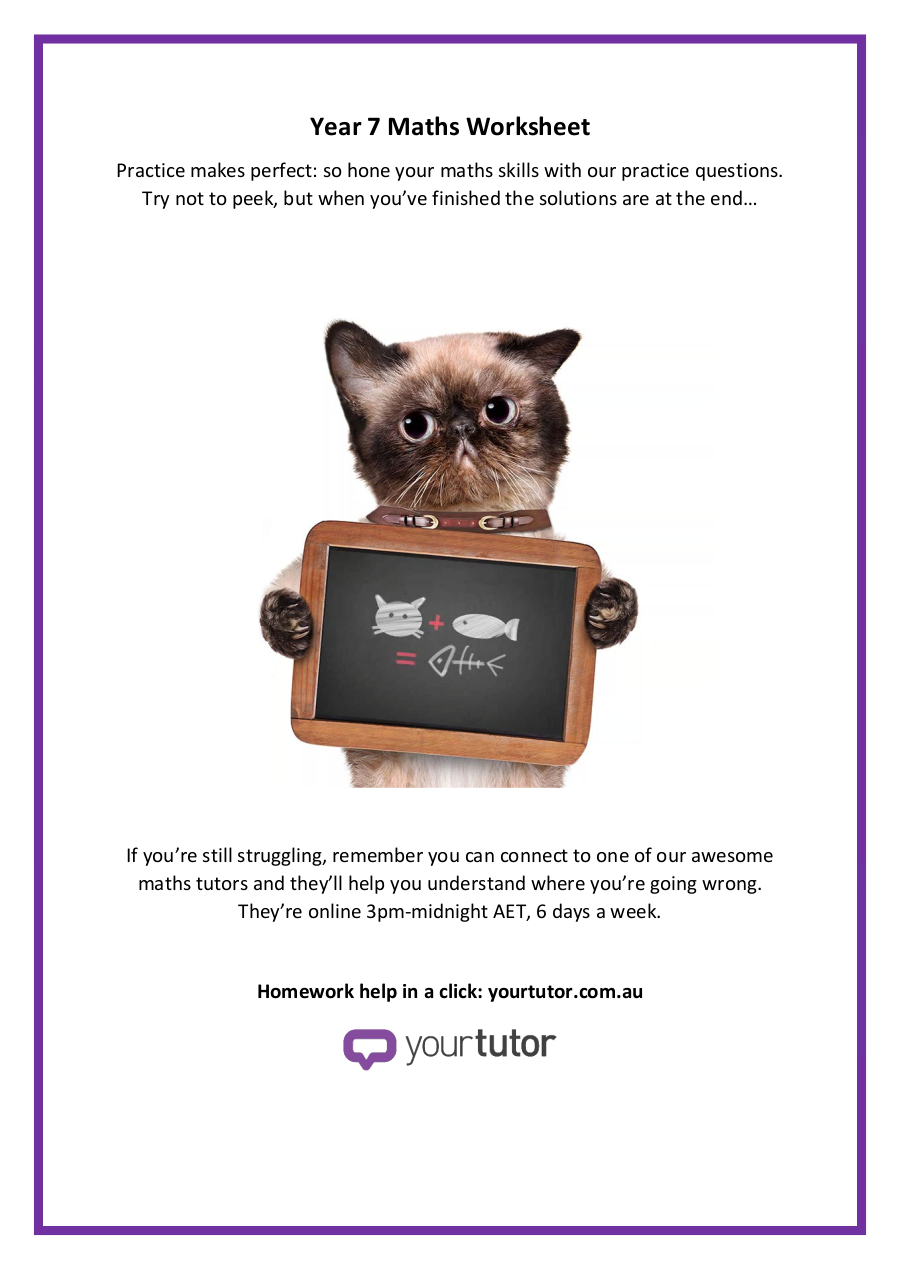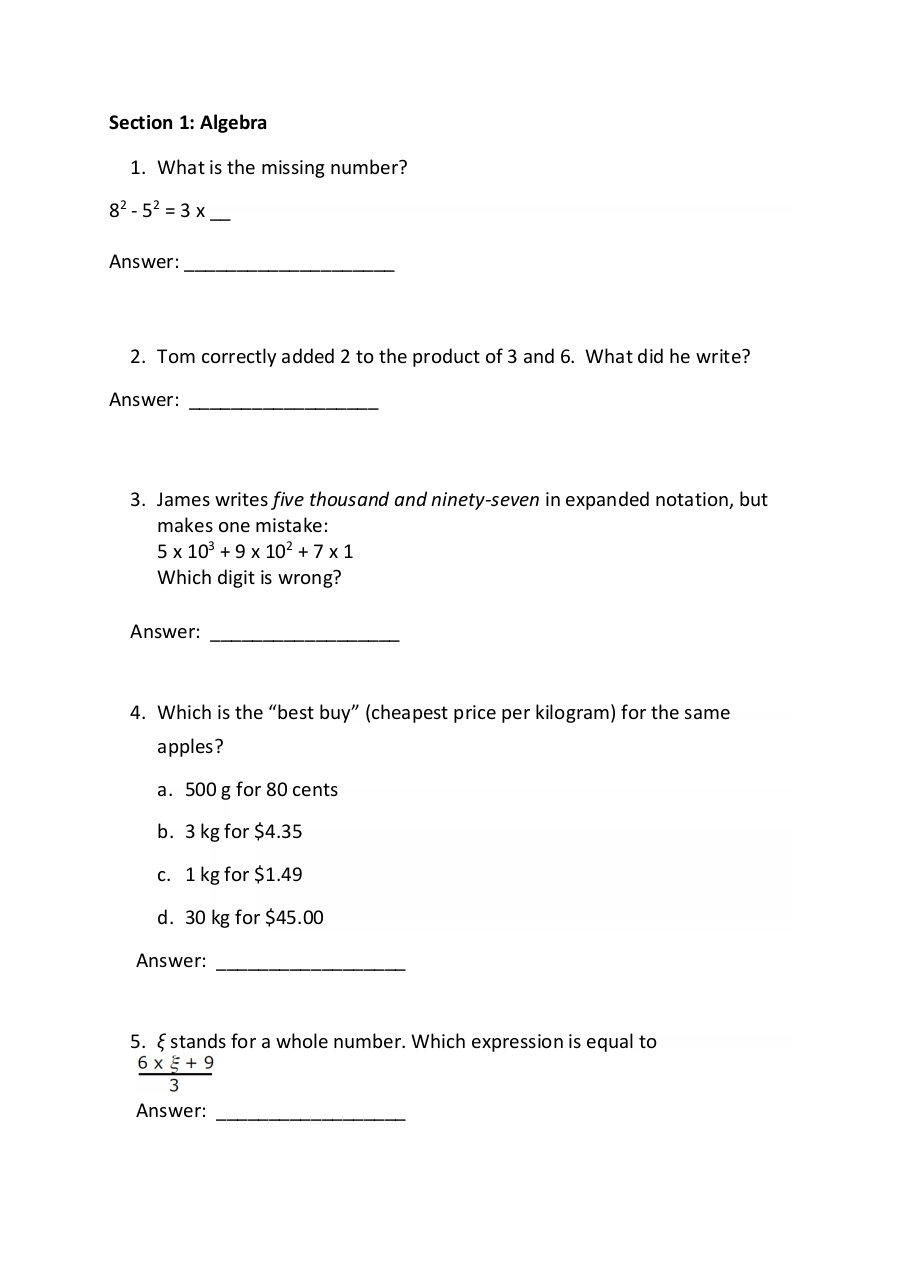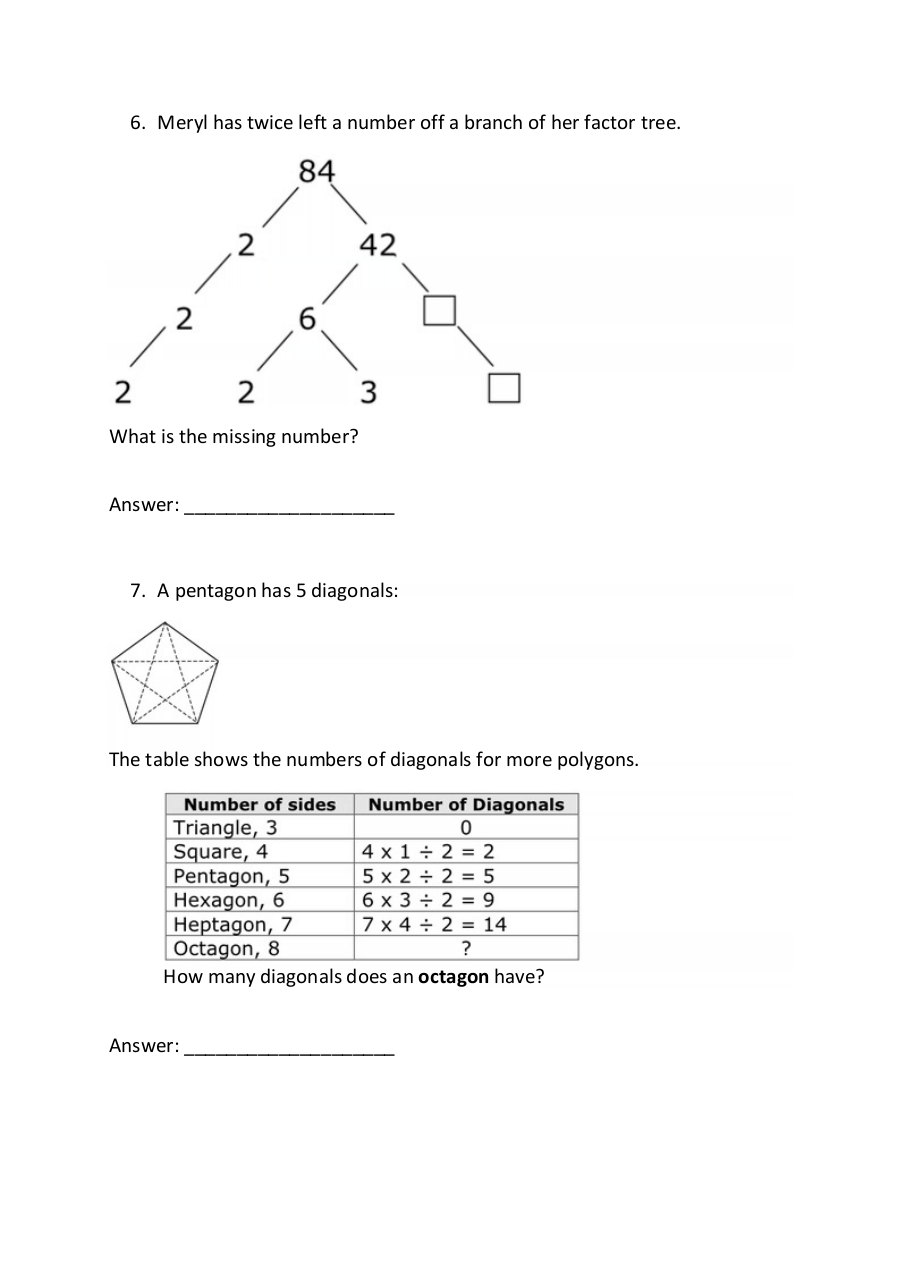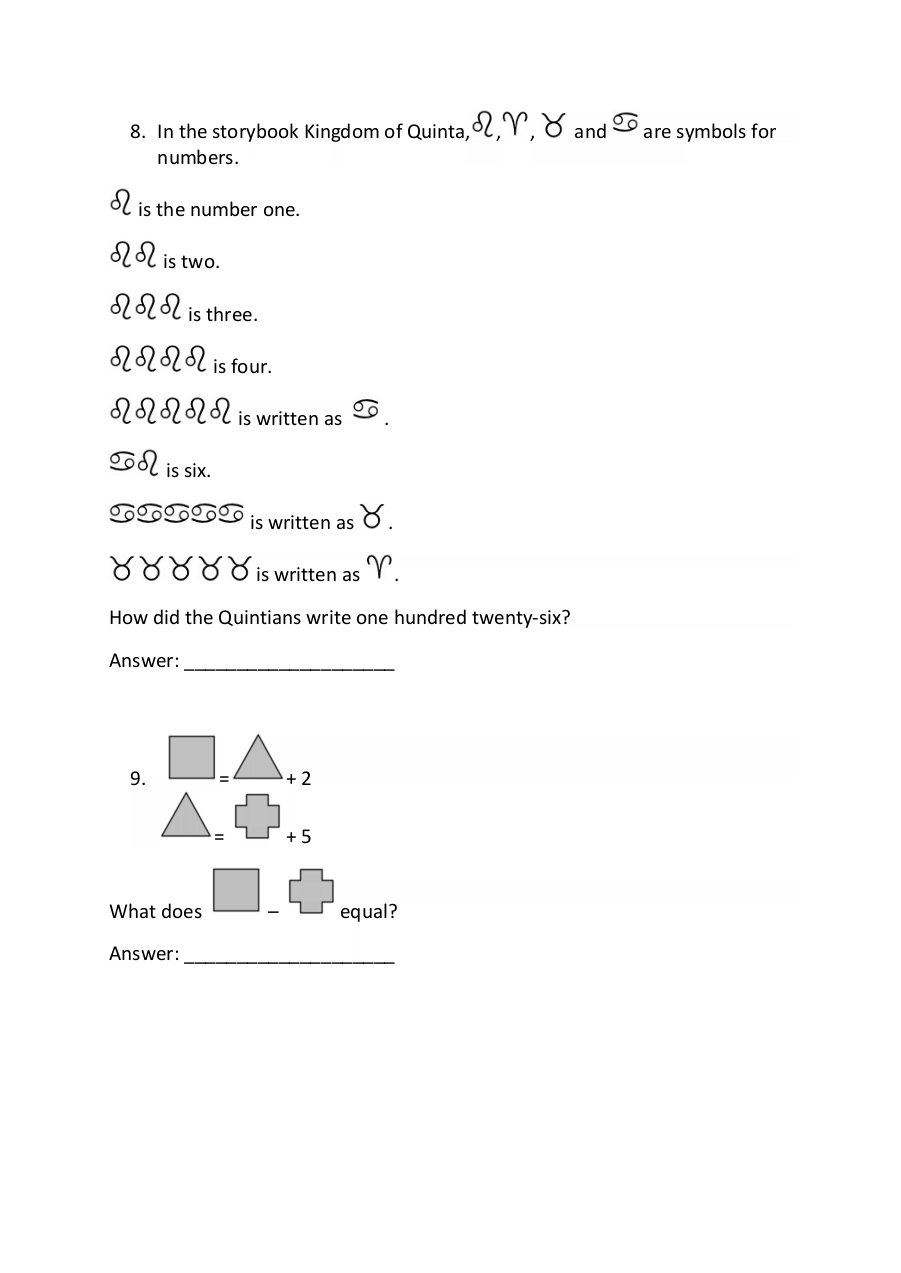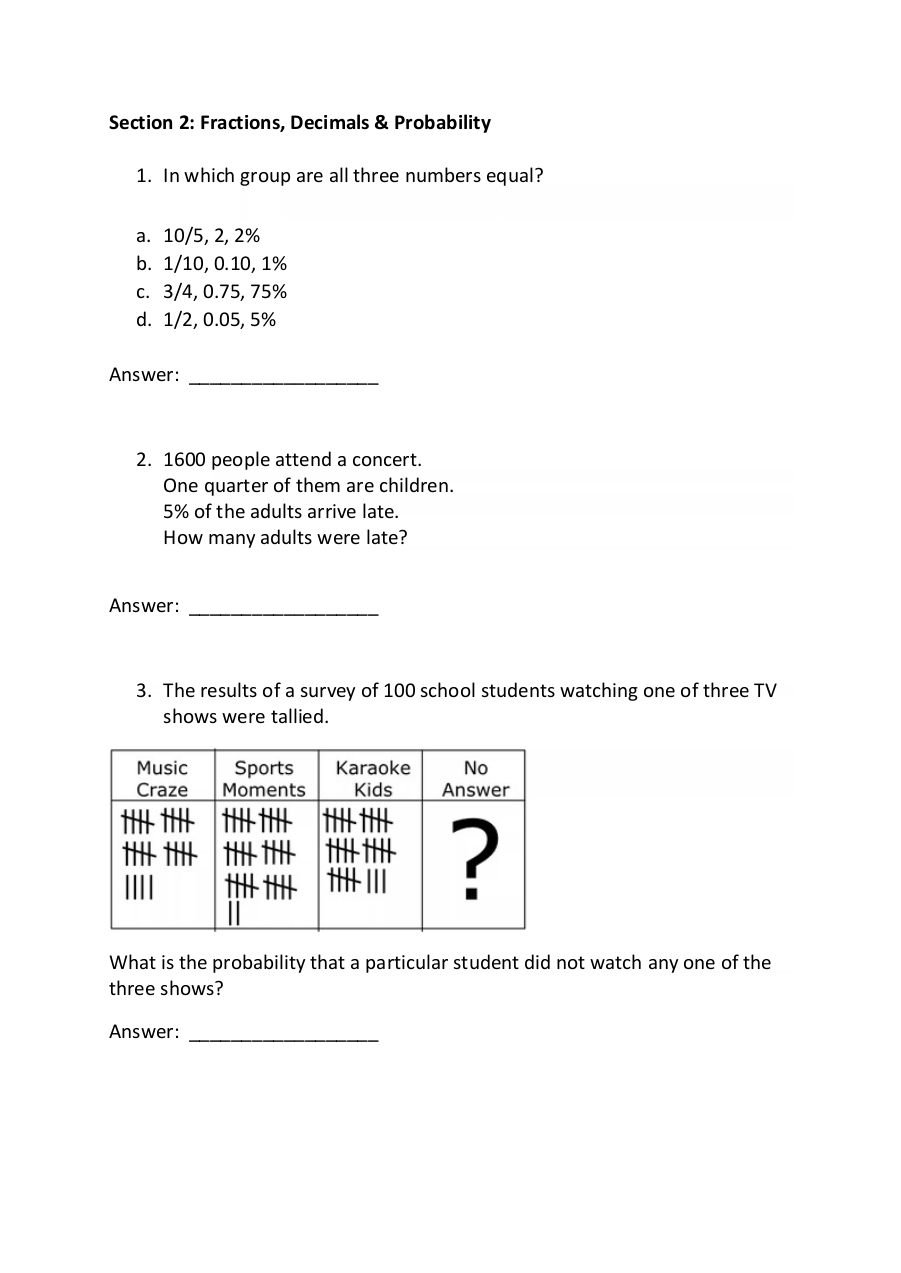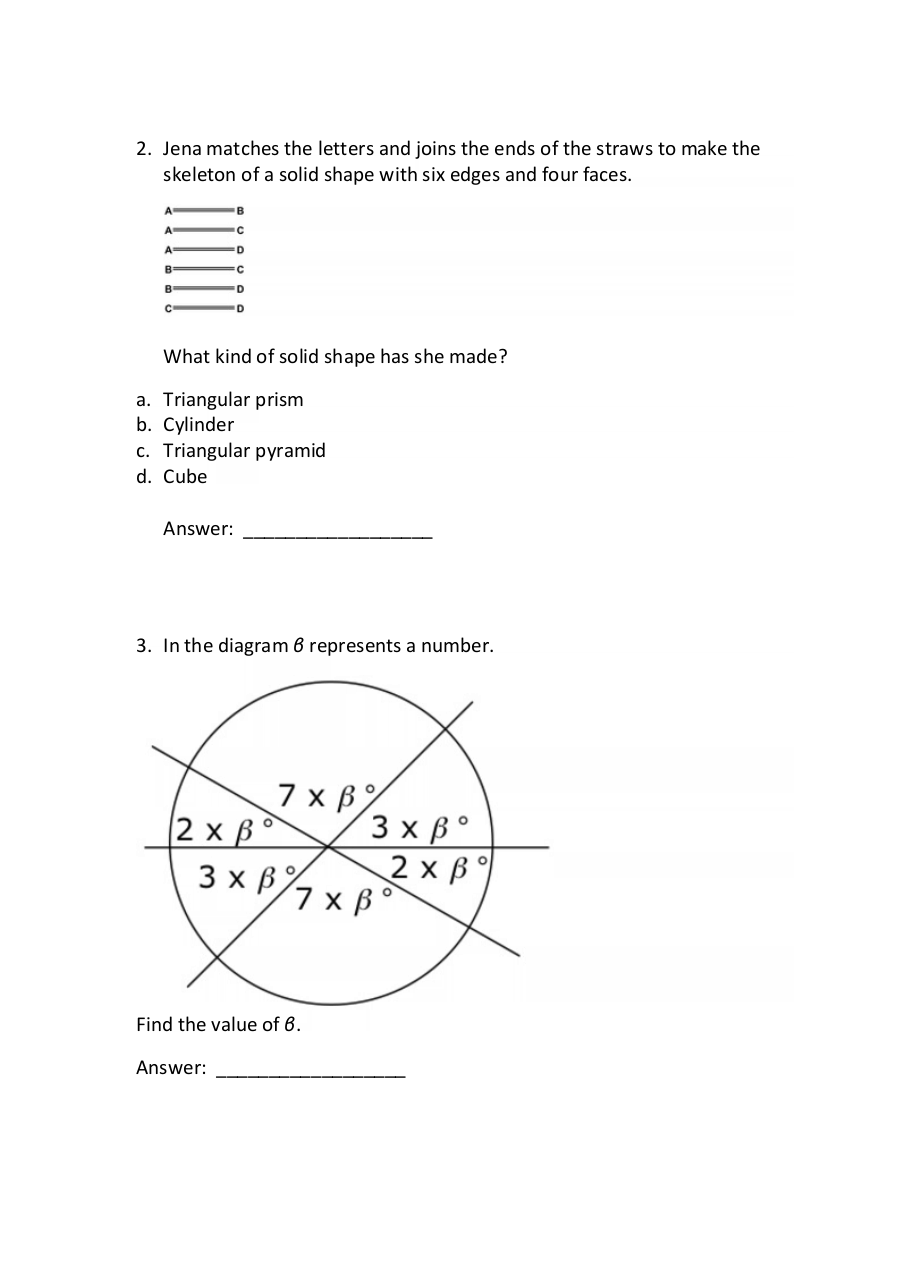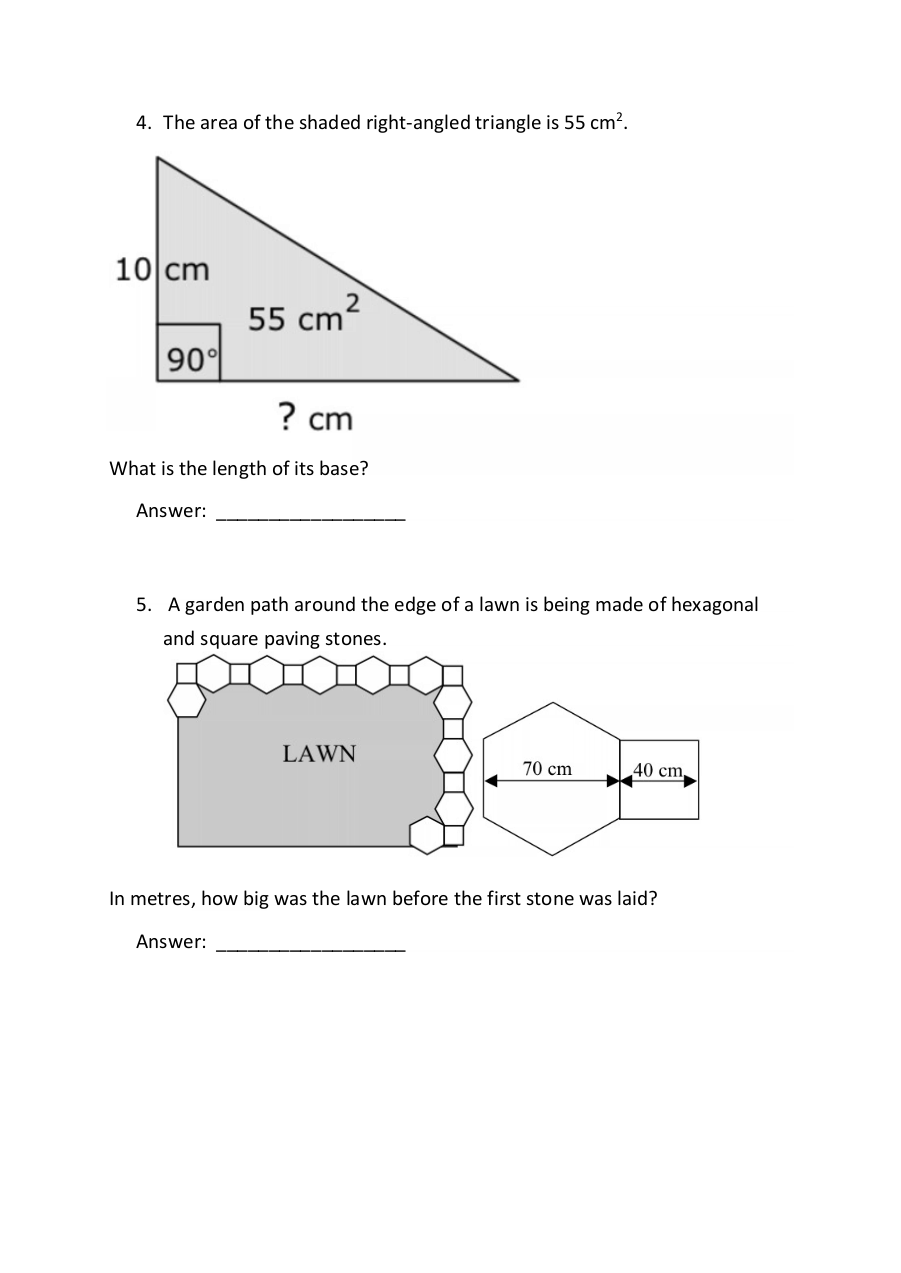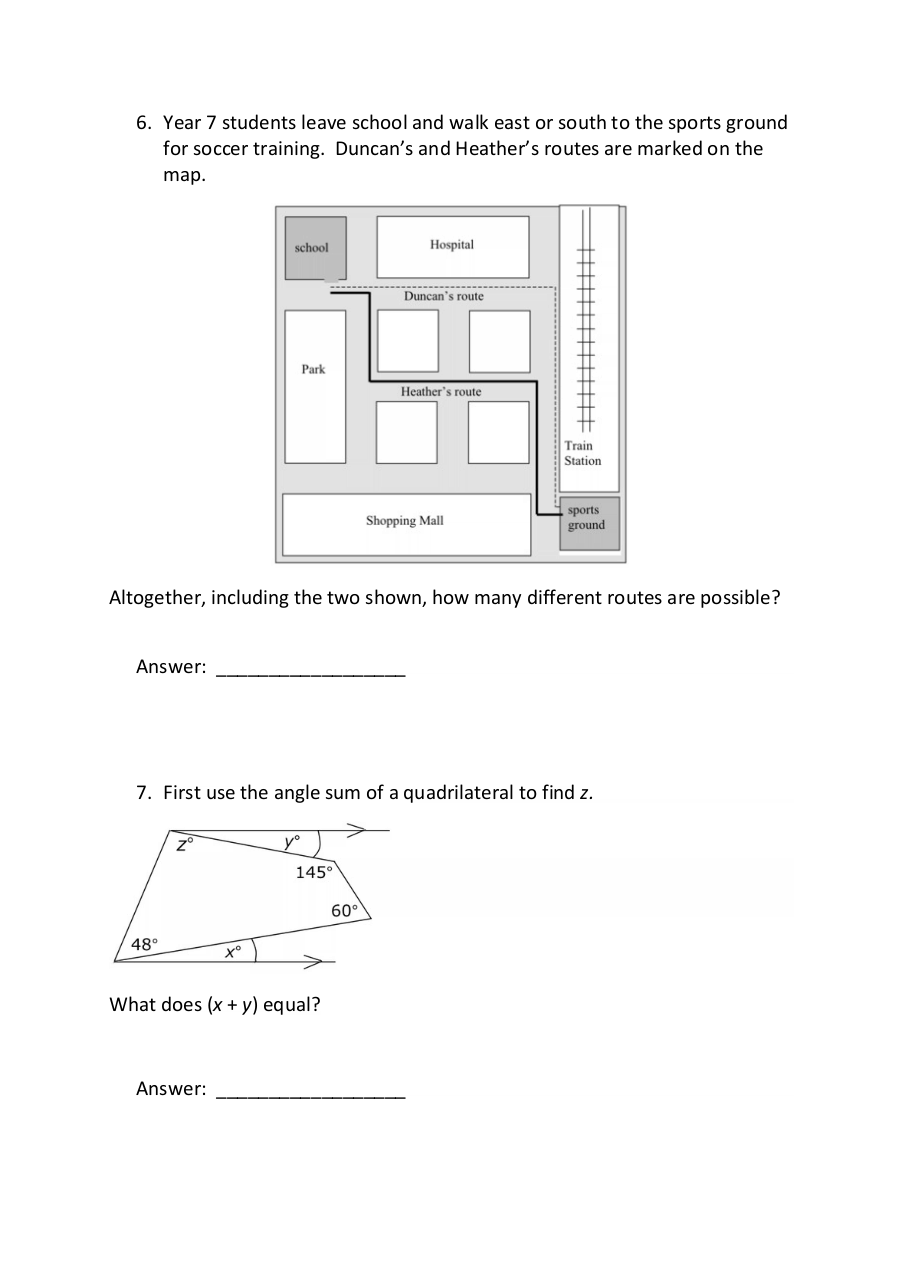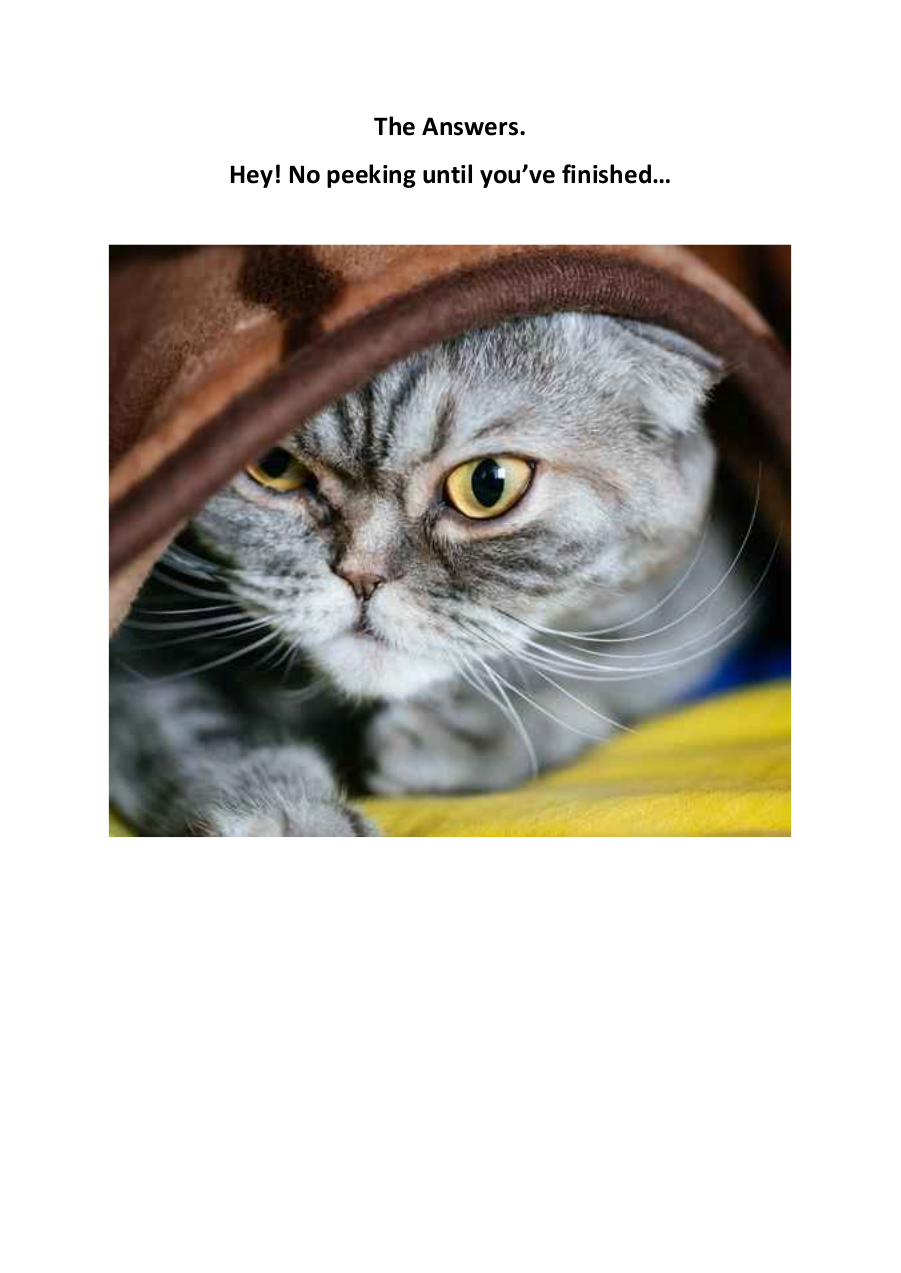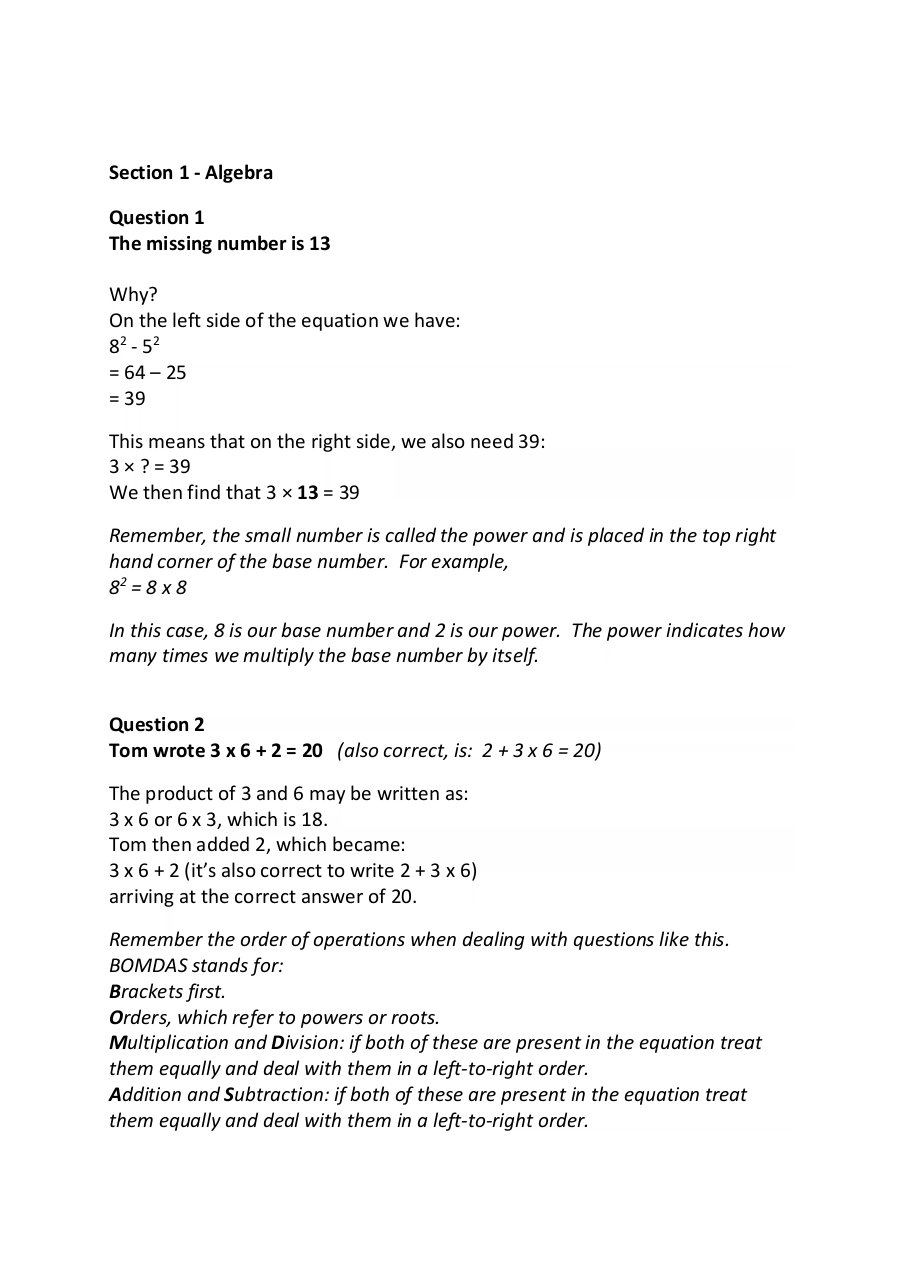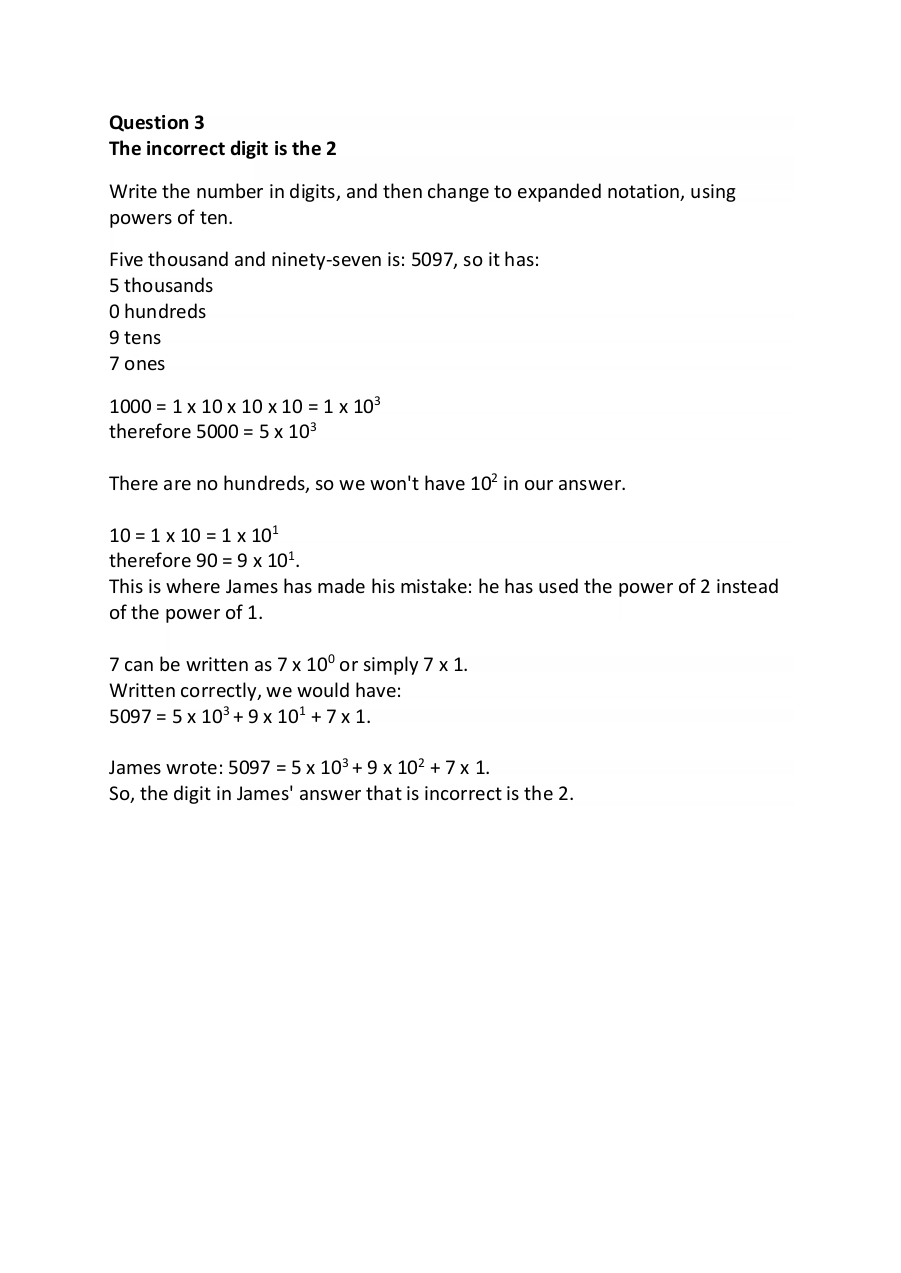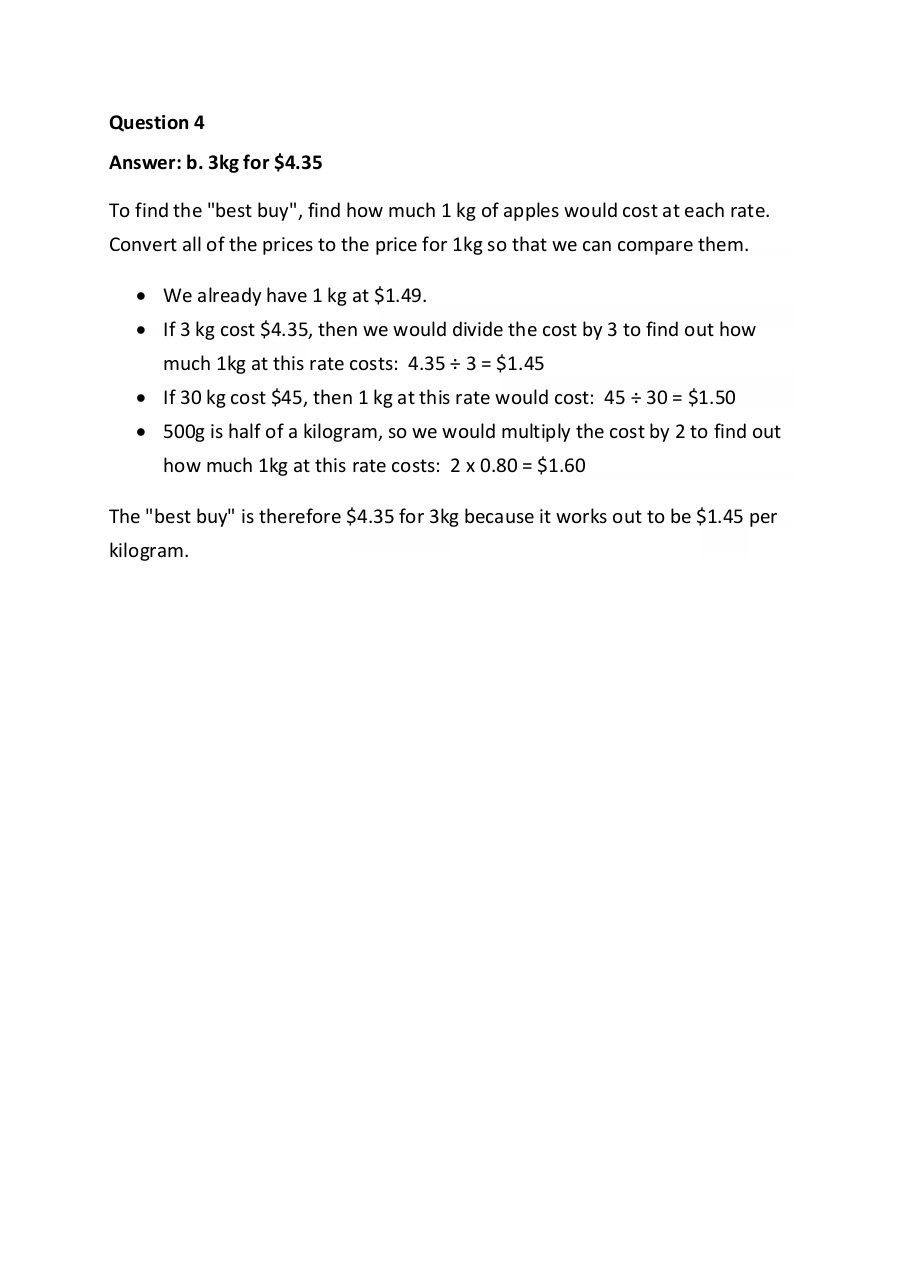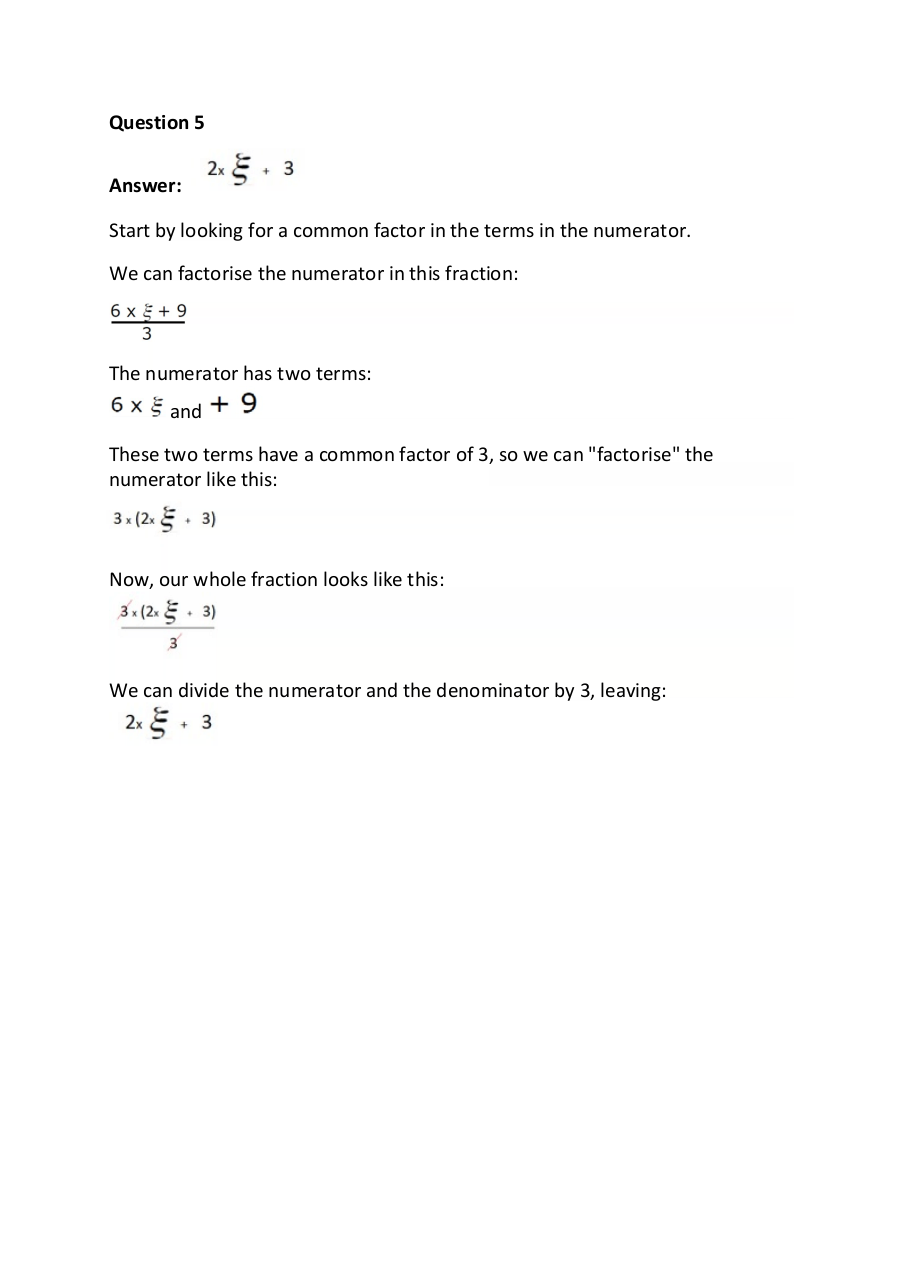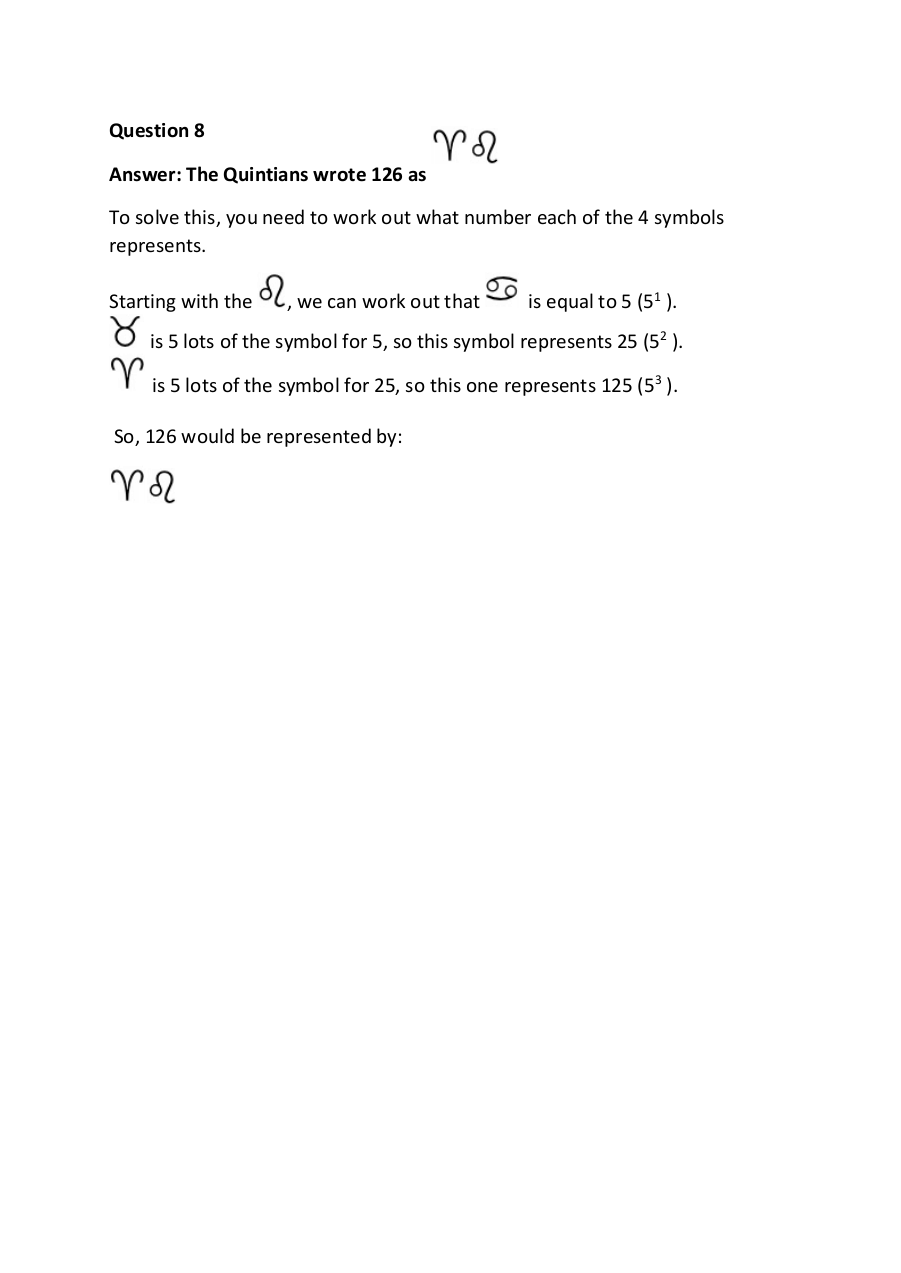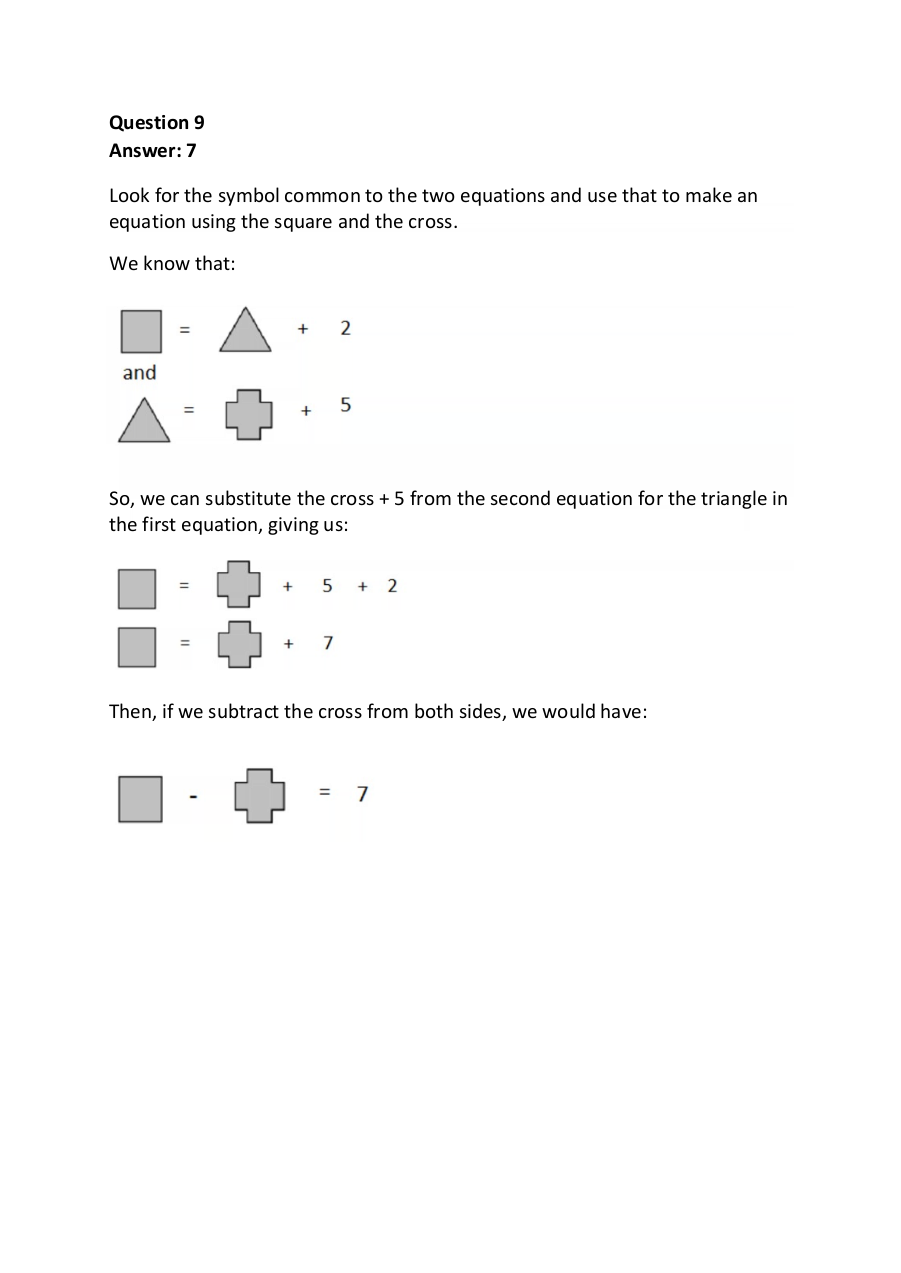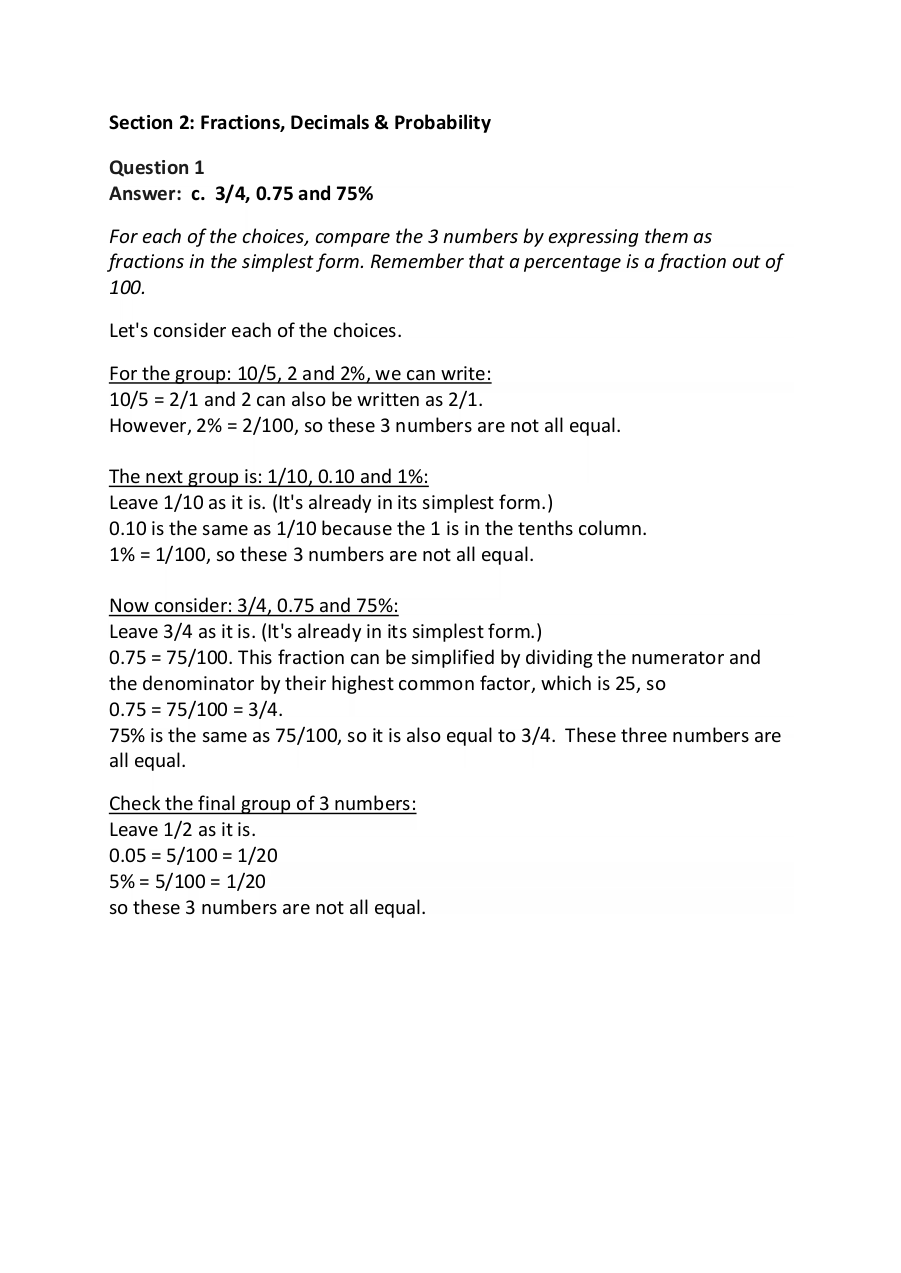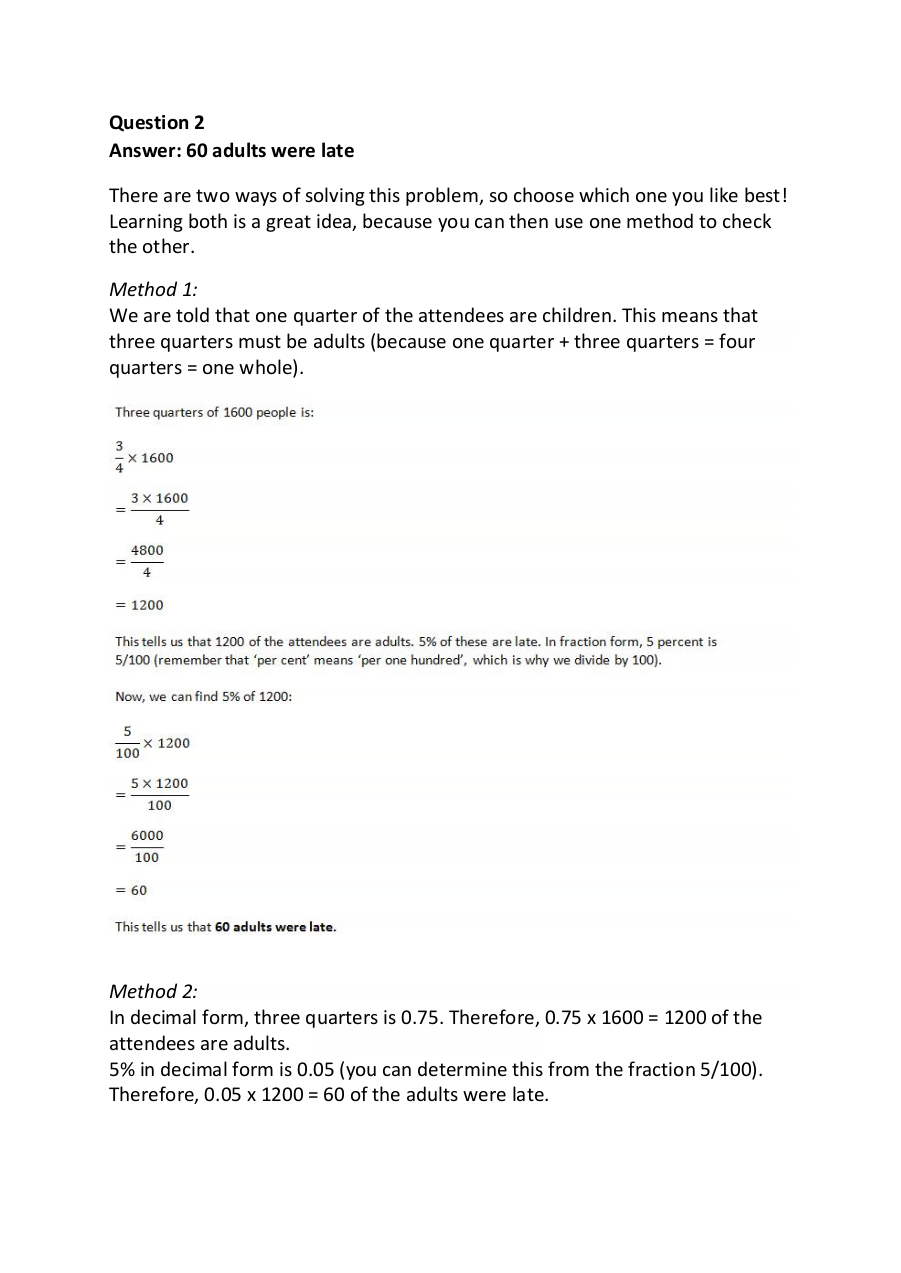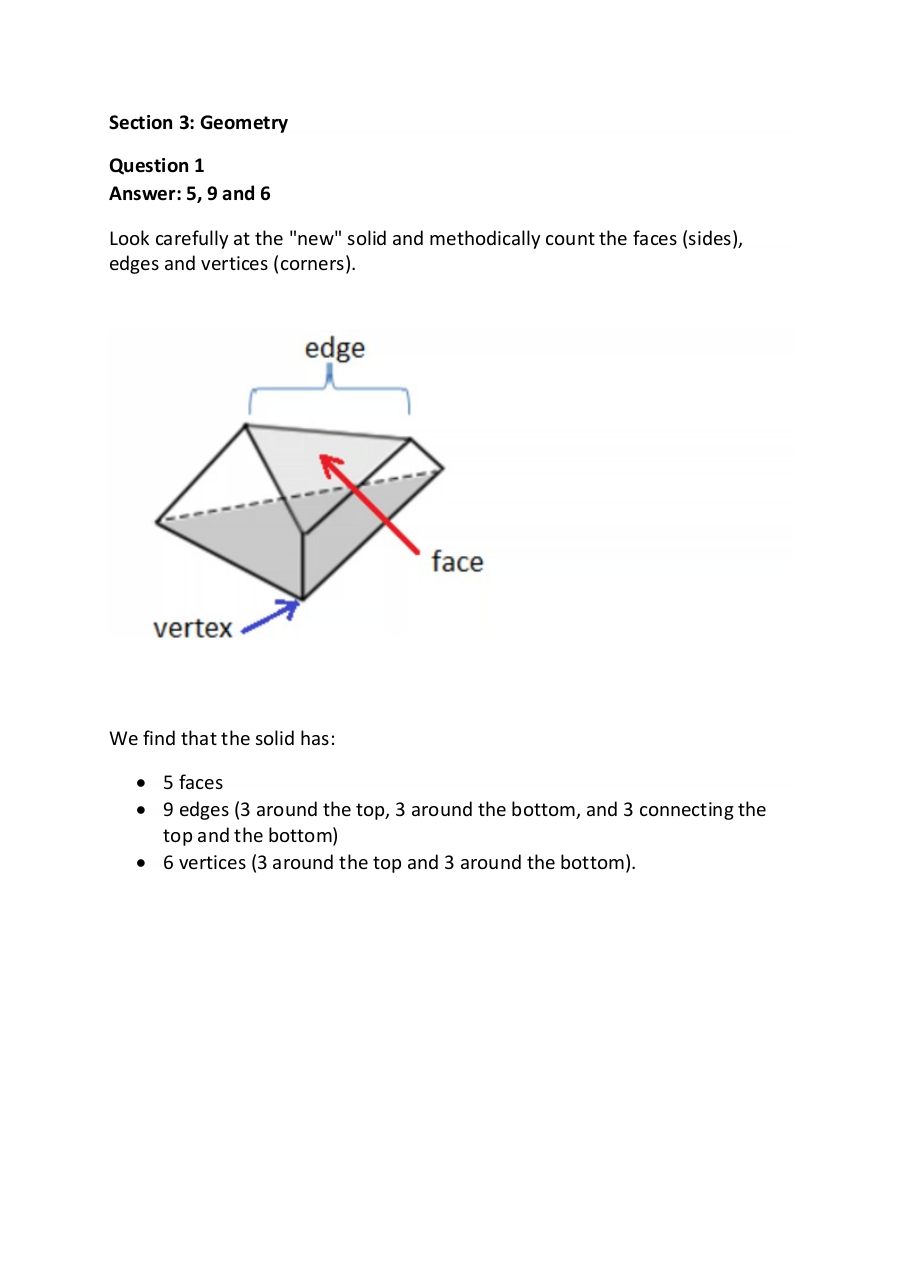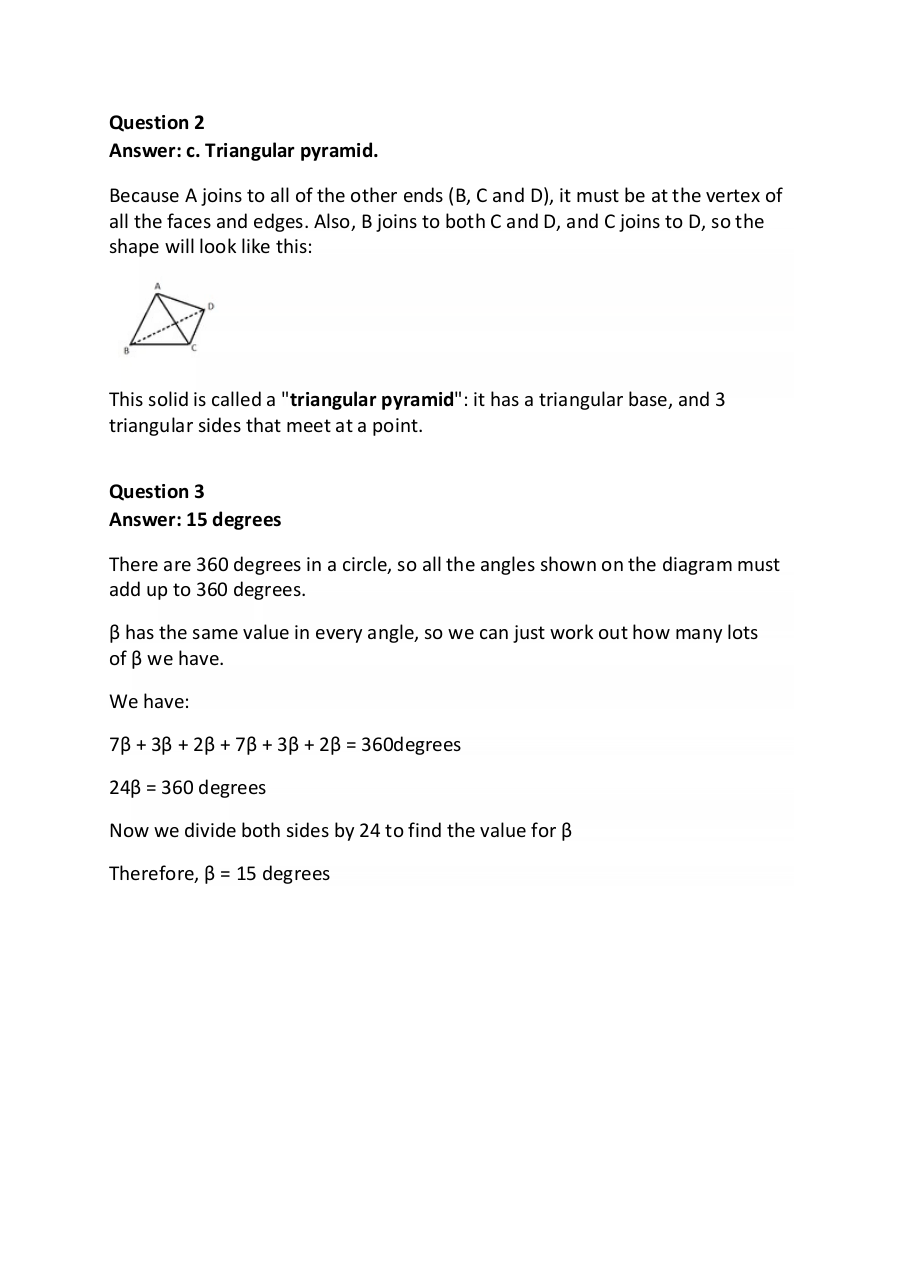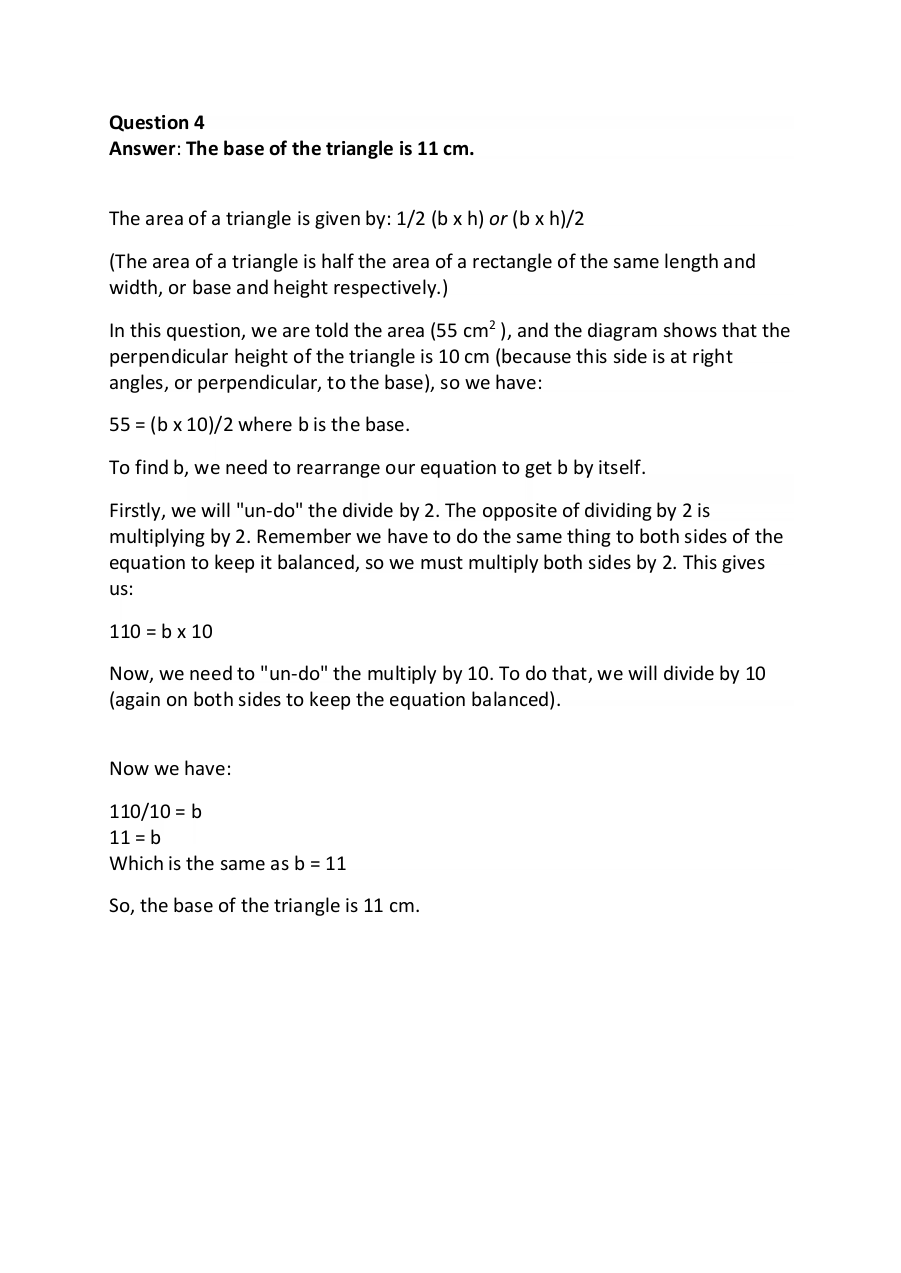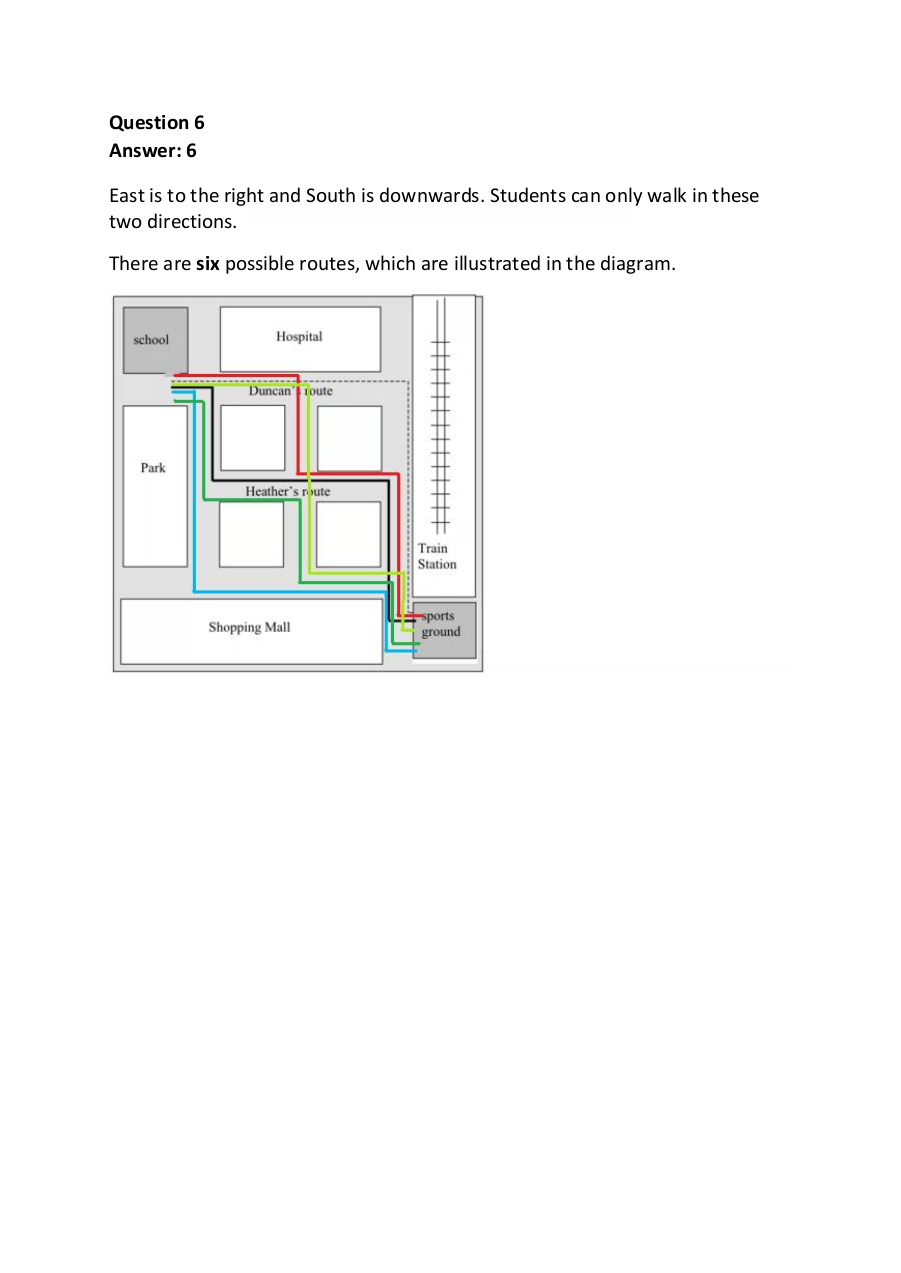Contributed by:
Year 7 Maths Practice Questions
1.
Year 7 Maths Worksheet
Practice makes perfect: so hone your maths skills with our practice questions.
Try not to peek, but when you’ve finished the solutions are at the end…
If you’re still struggling, remember you can connect to one of our awesome
maths tutors and they’ll help you understand where you’re going wrong.
They’re online 3pm-midnight AET, 6 days a week.
Homework help in a click: yourtutor.com.au
2.
Section 1: Algebra
1. What is the missing number?
82 - 52 = 3 x __
Answer: ____________________
2. Tom correctly added 2 to the product of 3 and 6. What did he write?
Answer: __________________
3. James writes five thousand and ninety-seven in expanded notation, but
makes one mistake:
5 x 103 + 9 x 102 + 7 x 1
Which digit is wrong?
Answer: __________________
4. Which is the “best buy” (cheapest price per kilogram) for the same
apples?
a. 500 g for 80 cents
b. 3 kg for $4.35
c. 1 kg for $1.49
d. 30 kg for $45.00
Answer: __________________
5. ξ stands for a whole number. Which expression is equal to
Answer: __________________
3.
6. Meryl has twice left a number off a branch of her factor tree.
What is the missing number?
Answer: ____________________
7. A pentagon has 5 diagonals:
The table shows the numbers of diagonals for more polygons.
How many diagonals does an octagon have?
Answer: ____________________
4.
8. In the storybook Kingdom of Quinta, , , and are symbols for
numbers.
is the number one.
is two.
is three.
is four.
is written as .
is six.
is written as .
is written as .
How did the Quintians write one hundred twenty-six?
Answer: ____________________
9. = +2
= +5
What does – equal?
Answer: ____________________
5.
Section 2: Fractions, Decimals & Probability
1. In which group are all three numbers equal?
a. 10/5, 2, 2%
b. 1/10, 0.10, 1%
c. 3/4, 0.75, 75%
d. 1/2, 0.05, 5%
Answer: __________________
2. 1600 people attend a concert.
One quarter of them are children.
5% of the adults arrive late.
How many adults were late?
Answer: __________________
3. The results of a survey of 100 school students watching one of three TV
shows were tallied.
What is the probability that a particular student did not watch any one of the
three shows?
Answer: __________________
6.
4. A packet of jellybeans has more red than black jellybeans and just as
many blue as white jellybeans.
There are no green jellybeans.
Sheila dips her hand in and takes a jellybean at random. Which
statement is true?
a. Sheila is more likely to pick a green jellybean than a blue jellybean.
b. Sheila will most likely pick a black jellybean.
c. Sheila has the same chance of picking a blue as picking a white jellybean.
d. Sheila has the same chance of picking a red as picking a black jellybean.
Answer: __________________
Section 3: Geometry
1. A triangular pyramid is cut into two polyhedra, (solids with flat faces and
straight edges).
How many faces, edges and vertices does the bottom piece have?
Answer: __________________
7.
2. Jena matches the letters and joins the ends of the straws to make the
skeleton of a solid shape with six edges and four faces.
What kind of solid shape has she made?
a. Triangular prism
b. Cylinder
c. Triangular pyramid
d. Cube
Answer: __________________
3. In the diagram β represents a number.
Find the value of β.
Answer: __________________
8.
4. The area of the shaded right-angled triangle is 55 cm2.
What is the length of its base?
Answer: __________________
5. A garden path around the edge of a lawn is being made of hexagonal
and square paving stones.
In metres, how big was the lawn before the first stone was laid?
Answer: __________________
9.
6. Year 7 students leave school and walk east or south to the sports ground
for soccer training. Duncan’s and Heather’s routes are marked on the
map.
Altogether, including the two shown, how many different routes are possible?
Answer: __________________
7. First use the angle sum of a quadrilateral to find z.
What does (x + y) equal?
Answer: __________________
10.
The Answers.
Hey! No peeking until you’ve finished…
11.
Section 1 - Algebra
Question 1
The missing number is 13
On the left side of the equation we have:
82 - 52
= 64 – 25
= 39
This means that on the right side, we also need 39:
3 × ? = 39
We then find that 3 × 13 = 39
Remember, the small number is called the power and is placed in the top right
hand corner of the base number. For example,
82 = 8 x 8
In this case, 8 is our base number and 2 is our power. The power indicates how
many times we multiply the base number by itself.
Question 2
Tom wrote 3 x 6 + 2 = 20 (also correct, is: 2 + 3 x 6 = 20)
The product of 3 and 6 may be written as:
3 x 6 or 6 x 3, which is 18.
Tom then added 2, which became:
3 x 6 + 2 (it’s also correct to write 2 + 3 x 6)
arriving at the correct answer of 20.
Remember the order of operations when dealing with questions like this.
BOMDAS stands for:
Brackets first.
Orders, which refer to powers or roots.
Multiplication and Division: if both of these are present in the equation treat
them equally and deal with them in a left-to-right order.
Addition and Subtraction: if both of these are present in the equation treat
them equally and deal with them in a left-to-right order.
12.
Question 3
The incorrect digit is the 2
Write the number in digits, and then change to expanded notation, using
powers of ten.
Five thousand and ninety-seven is: 5097, so it has:
5 thousands
0 hundreds
9 tens
7 ones
1000 = 1 x 10 x 10 x 10 = 1 x 103
therefore 5000 = 5 x 103
There are no hundreds, so we won't have 102 in our answer.
10 = 1 x 10 = 1 x 101
therefore 90 = 9 x 101.
This is where James has made his mistake: he has used the power of 2 instead
of the power of 1.
7 can be written as 7 x 100 or simply 7 x 1.
Written correctly, we would have:
5097 = 5 x 103 + 9 x 101 + 7 x 1.
James wrote: 5097 = 5 x 103 + 9 x 102 + 7 x 1.
So, the digit in James' answer that is incorrect is the 2.
13.
Question 4
Answer: b. 3kg for $4.35
To find the "best buy", find how much 1 kg of apples would cost at each rate.
Convert all of the prices to the price for 1kg so that we can compare them.
• We already have 1 kg at $1.49.
• If 3 kg cost $4.35, then we would divide the cost by 3 to find out how
much 1kg at this rate costs: 4.35 ÷ 3 = $1.45
• If 30 kg cost $45, then 1 kg at this rate would cost: 45 ÷ 30 = $1.50
• 500g is half of a kilogram, so we would multiply the cost by 2 to find out
how much 1kg at this rate costs: 2 x 0.80 = $1.60
The "best buy" is therefore $4.35 for 3kg because it works out to be $1.45 per
14.
Question 5
Start by looking for a common factor in the terms in the numerator.
We can factorise the numerator in this fraction:
The numerator has two terms:
and
These two terms have a common factor of 3, so we can "factorise" the
numerator like this:
Now, our whole fraction looks like this:
We can divide the numerator and the denominator by 3, leaving:
15.
Question 6
Answer: 7
The numbers in each line of a factor tree must multiply together to give the
number you started with. Meryl is making a factor tree for 84. To start off, she
has chosen two factors: 2 and 42, which is correct. (2 x 42 = 84).
On the next line, she has kept the 2 (because 2 is a prime number and cannot
be broken down into any factors apart from 2 x 1), but she has only written in
one factor of 42.
She needs to show both factors. To find the missing factor, we need to think: 6
times what gives us 42? 6 x 7 is 42, so 7 is the missing factor.
On the next line, Meryl has kept the 2 again, and broken down the 6 into 2 x
3. Once again, she has forgotten to write in the 7.
With the 7 written in in both places, her factor tree would be complete, as 2 x
2 x 3 x 7 are the prime factors of 84.
Question 7
Answer: An octagon has 20 diagonals
Look at each of the calculations - can you see a pattern?
For the 4 sided shape, we multiply by 1 and then divide by 2.
For the 5 sided shape, we multiply by 2 and then divide by 2.
For the 6 sided shape, we multiply by 3 and then divide by 2.
So, it looks like we have to multiply the number of sides by the number of sides
less 3, and then divide by 2:
1 is 3 less than 4, 2 is 3 less than 5, 3 is 3 less than 6.
Using this rule for an octagon, which has 8 sides, we would have:
8 x 5 ÷ 2 = 20.
We can also look at the pattern in the number of diagonals. Starting with the
square, this goes: 2 5 9 14
These numbers increase by 3, then 4 and then 5, so we would expect the next
one to be 6 more than 14, which again, is 20.
So, we can conclude that an octagon would have 20 diagonals. (Try drawing a
diagram to check.)
16.
Question 8
Answer: The Quintians wrote 126 as
To solve this, you need to work out what number each of the 4 symbols
Starting with the , we can work out that is equal to 5 (51 ).
is 5 lots of the symbol for 5, so this symbol represents 25 (52 ).
is 5 lots of the symbol for 25, so this one represents 125 (53 ).
So, 126 would be represented by:
17.
Question 9
Answer: 7
Look for the symbol common to the two equations and use that to make an
equation using the square and the cross.
We know that:
So, we can substitute the cross + 5 from the second equation for the triangle in
the first equation, giving us:
Then, if we subtract the cross from both sides, we would have:
18.
Section 2: Fractions, Decimals & Probability
Question 1
Answer: c. 3/4, 0.75 and 75%
For each of the choices, compare the 3 numbers by expressing them as
fractions in the simplest form. Remember that a percentage is a fraction out of
Let's consider each of the choices.
For the group: 10/5, 2 and 2%, we can write:
10/5 = 2/1 and 2 can also be written as 2/1.
However, 2% = 2/100, so these 3 numbers are not all equal.
The next group is: 1/10, 0.10 and 1%:
Leave 1/10 as it is. (It's already in its simplest form.)
0.10 is the same as 1/10 because the 1 is in the tenths column.
1% = 1/100, so these 3 numbers are not all equal.
Now consider: 3/4, 0.75 and 75%:
Leave 3/4 as it is. (It's already in its simplest form.)
0.75 = 75/100. This fraction can be simplified by dividing the numerator and
the denominator by their highest common factor, which is 25, so
0.75 = 75/100 = 3/4.
75% is the same as 75/100, so it is also equal to 3/4. These three numbers are
all equal.
Check the final group of 3 numbers:
Leave 1/2 as it is.
0.05 = 5/100 = 1/20
5% = 5/100 = 1/20
so these 3 numbers are not all equal.
19.
Question 2
Answer: 60 adults were late
There are two ways of solving this problem, so choose which one you like best!
Learning both is a great idea, because you can then use one method to check
the other.
Method 1:
We are told that one quarter of the attendees are children. This means that
three quarters must be adults (because one quarter + three quarters = four
quarters = one whole).
Method 2:
In decimal form, three quarters is 0.75. Therefore, 0.75 x 1600 = 1200 of the
attendees are adults.
5% in decimal form is 0.05 (you can determine this from the fraction 5/100).
Therefore, 0.05 x 1200 = 60 of the adults were late.
20.
The difference between these two methods is that one uses fractions and one
uses decimals. You can even use combinations of both to get your answer.
Question 3
Answer: 16% of students didn’t watch any of the shows
Find the number of students who gave "no answer" in the survey. Remember
that a percentage is just a fraction out of 100.
First, find the totals for each of the three programs. Remember that 4 tally
marks with a diagonal line through them makes a group of 5, so the totals are:
Music Craze: 24 students
Sports Moments: 32 students
Karakoke Kids: 28 students
So, the three shows account for:
24 + 32 + 28 = 84 students.
To find the number who gave "no answer", we need to subtract this total from
100 - 84 = 16 students.
So, 16/100 students gave "no answer". 16/100 = 16%
So, the probability that a student did not watch any of the three show is 16%.
21.
Question 4
Answer: Option d.
a. Sheila will most likely pick a black jellybean: This is false. There are more
red jellybeans than black ones, so it is more likely that we would pick a
red one than a black one. We also have no information about how many
red or black jellybeans there are compared to blue and white jelly beans.
b. Sheila is more likely to pick a green jellybean than a blue jelly bean: This
is false. There are no green jellybeans.
c. Sheila has the same chance of picking a red as picking a black
jellybean: This is false, because there are more red than black jellybeans.
Therefore there is more chance of picking a red than a black.
d. Sheila has the same chance of picking a blue as picking a white
jellybean: This is true, because there are just as many blue as white
jellybeans.
22.
Section 3: Geometry
Question 1
Answer: 5, 9 and 6
Look carefully at the "new" solid and methodically count the faces (sides),
edges and vertices (corners).
We find that the solid has:
• 5 faces
• 9 edges (3 around the top, 3 around the bottom, and 3 connecting the
top and the bottom)
• 6 vertices (3 around the top and 3 around the bottom).
23.
Question 2
Answer: c. Triangular pyramid.
Because A joins to all of the other ends (B, C and D), it must be at the vertex of
all the faces and edges. Also, B joins to both C and D, and C joins to D, so the
shape will look like this:
This solid is called a "triangular pyramid": it has a triangular base, and 3
triangular sides that meet at a point.
Question 3
Answer: 15 degrees
There are 360 degrees in a circle, so all the angles shown on the diagram must
add up to 360 degrees.
β has the same value in every angle, so we can just work out how many lots
of β we have.
We have:
7β + 3β + 2β + 7β + 3β + 2β = 360degrees
24β = 360 degrees
Now we divide both sides by 24 to find the value for β
Therefore, β = 15 degrees
24.
Question 4
Answer: The base of the triangle is 11 cm.
The area of a triangle is given by: 1/2 (b x h) or (b x h)/2
(The area of a triangle is half the area of a rectangle of the same length and
width, or base and height respectively.)
In this question, we are told the area (55 cm2 ), and the diagram shows that the
perpendicular height of the triangle is 10 cm (because this side is at right
angles, or perpendicular, to the base), so we have:
55 = (b x 10)/2 where b is the base.
To find b, we need to rearrange our equation to get b by itself.
Firstly, we will "un-do" the divide by 2. The opposite of dividing by 2 is
multiplying by 2. Remember we have to do the same thing to both sides of the
equation to keep it balanced, so we must multiply both sides by 2. This gives
110 = b x 10
Now, we need to "un-do" the multiply by 10. To do that, we will divide by 10
(again on both sides to keep the equation balanced).
Now we have:
110/10 = b
11 = b
Which is the same as b = 11
So, the base of the triangle is 11 cm.
25.
Question 5
Answer: 5.9 m x 3.7 m
The length of the lawn is 5 hexagonal pavers plus 6 square pavers. This is:
5 x 70cm + 6 x 40cm
= 350cm + 240cm
= 590 cm.
The width of the lawn is 3 hexagonal pavers plus 4 square pavers. This is:
3 x 70cm + 4 x 40cm
= 210cm + 160cm
= 370 cm
Area of a rectangle is given by: length x width, so
Area of the lawn = 590 cm x 370 cm
= 5.9 m x 3.7 m (because 1 m = 100 cm).
26.
Question 6
Answer: 6
East is to the right and South is downwards. Students can only walk in these
two directions.
There are six possible routes, which are illustrated in the diagram.
27.
Question 7
Answer: 25°
In a quadrilateral, the sum of angles is 360°. Therefore,
z° = 360° - 145° - 60° - 48°
z° = 360° - 253°
z° = 107°
Now, we can use the supplementary rule for parallel lines. If a single line
crosses two parallel lines, the sum of the internal angles equal 180°.
This means that:
x + y + 48° + z° = 180°
x + y + 48° + 107° = 180°
x + y = 180° - 48° - 107°
x + y = 180° - 155°
x + y = 25°
